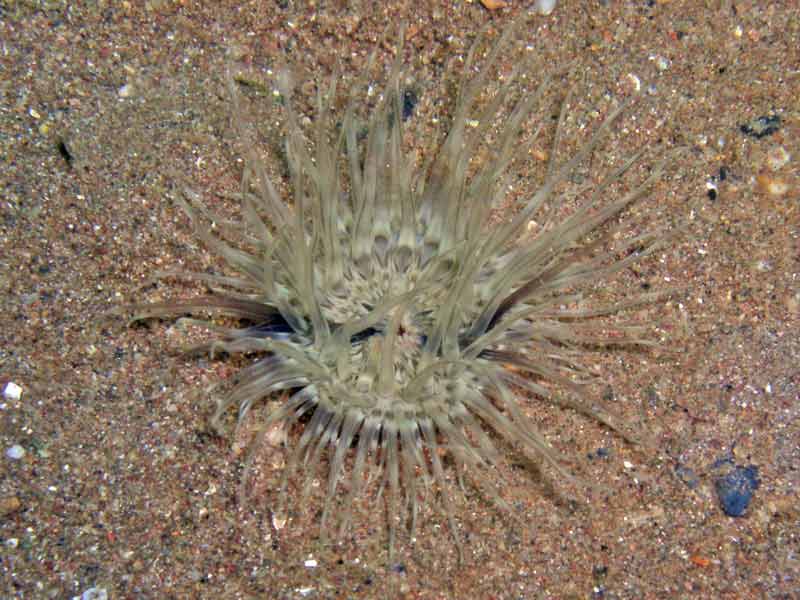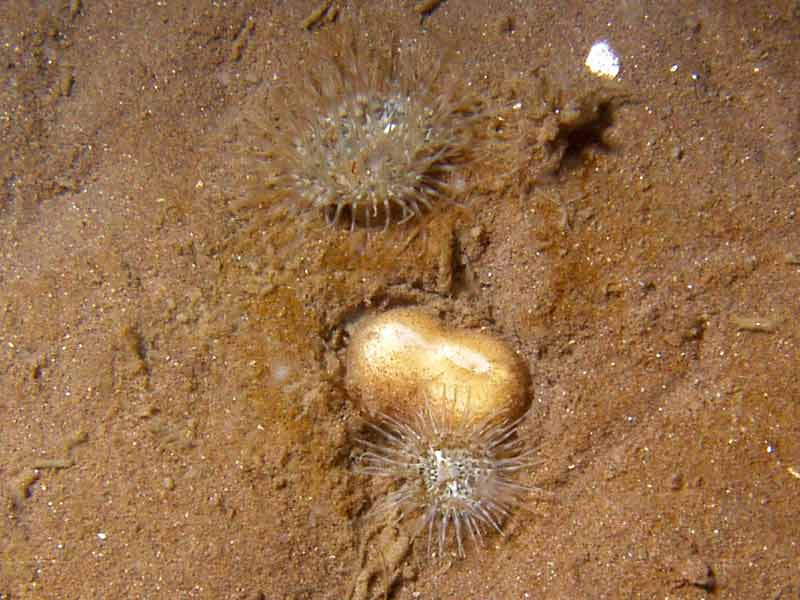A sea anemone (Sagartia undata)
Distribution data supplied by the Ocean Biodiversity Information System (OBIS). To interrogate UK data visit the NBN Atlas.Map Help
| Researched by | Emily Wilson | Refereed by | Admin |
| Authority | (Müller, 1778) | ||
| Other common names | - | Synonyms | Sagartiogeton undatus (Müller, 1778) |
Summary
Description
A graceful sea anemone with long tentacles arranged in multiples of six. It grows up to 12 cm tall and 6 cm across the base which is strongly adherent. The disc and tentacles are translucent pale greyish in colour, while the disc is variegated with cream, and with a regular but not striking pattern. The tentacles have lateral dark lines down their length. The column is tall in extension with no suckers and pale yellowish buff in colour, with regular vertical stripes of brown flecks of variable intensity.
Recorded distribution in Britain and Ireland
Present on all British and Irish coats.Global distribution
Scandinavia to Mediterranean.Habitat
Typically found buried in sand or gravel, attached to a stone or shell 10-15 cm into the sediment or in crevices or holes in rocks. Found on the lower shore and sublittoral to a depth of at least 100 m.Depth range
Lower shore to 100mIdentifying features
- Column at full extension up to 12 cm high and 2 cm diameter.
- Oral disc wider than column, with an unusually wide mouth.
- Tentacles up to 200, long, slender, arranged hexamerously.
- No suckers.
- Striped pattern on column is consistent and distinctive.
Additional information
The taxonomy of the family Sagartiidae was recently examined by Sanamyan & Sanamyan (2020) who concluded that the genus Sagartia was not valid and should be assigned to the genus Cylista. Cylista undata is often found in the company of Sagartia troglodytes or Cereus pedunculatus, where these occur buried, and in the past has been confused with both these species although easily distinguished from them by its lack of suckers. Philip Henry Gosse christened this species the Snakelocks, but this name proved popular with the more common species Anemonia viridis.
Listed by
- none -
Bibliography
Hayward, P., Nelson-Smith, T. & Shields, C. 1996. Collins pocket guide. Sea shore of Britain and northern Europe. London: HarperCollins.
Hayward, P.J. & Ryland, J.S. (ed.) 1995b. Handbook of the marine fauna of North-West Europe. Oxford: Oxford University Press.
Howson, C.M. & Picton, B.E., 1997. The species directory of the marine fauna and flora of the British Isles and surrounding seas. Belfast: Ulster Museum. [Ulster Museum publication, no. 276.]
Manuel, R.L., 1988. British Anthozoa. Synopses of the British Fauna (New Series) (ed. D.M. Kermack & R.S.K. Barnes). The Linnean Society of London [Synopses of the British Fauna No. 18.]. DOI https://doi.org/10.1002/iroh.19810660505
Datasets
Centre for Environmental Data and Recording, 2018. Ulster Museum Marine Surveys of Northern Ireland Coastal Waters. Occurrence dataset https://www.nmni.com/CEDaR/CEDaR-Centre-for-Environmental-Data-and-Recording.aspx accessed via NBNAtlas.org on 2018-09-25.
Fenwick, 2018. Aphotomarine. Occurrence dataset http://www.aphotomarine.com/index.html Accessed via NBNAtlas.org on 2018-10-01
Isle of Wight Local Records Centre, 2017. IOW Natural History & Archaeological Society Marine Invertebrate Records 1853- 2011. Occurrence dataset: https://doi.org/10.15468/d9amhg accessed via GBIF.org on 2018-09-27.
Kent Wildlife Trust, 2018. Kent Wildlife Trust Shoresearch Intertidal Survey 2004 onwards. Occurrence dataset: https://www.kentwildlifetrust.org.uk/ accessed via NBNAtlas.org on 2018-10-01.
Lancashire Environment Record Network, 2018. LERN Records. Occurrence dataset: https://doi.org/10.15468/esxc9a accessed via GBIF.org on 2018-10-01.
NBN (National Biodiversity Network) Atlas. Available from: https://www.nbnatlas.org.
OBIS (Ocean Biodiversity Information System), 2025. Global map of species distribution using gridded data. Available from: Ocean Biogeographic Information System. www.iobis.org. Accessed: 2025-08-08
South East Wales Biodiversity Records Centre, 2023. SEWBReC Marine and other Aquatic Invertebrates (South East Wales). Occurrence dataset:https://doi.org/10.15468/zxy1n6 accessed via GBIF.org on 2024-09-27.
Citation
This review can be cited as:
Last Updated: 20/04/2007






